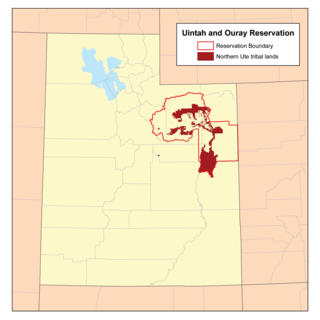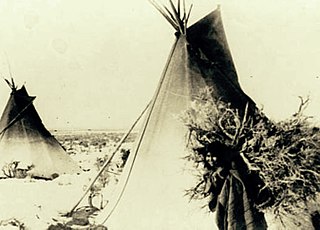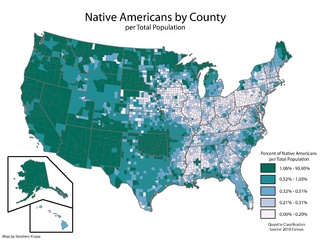
Manti is a city in and the county seat of Sanpete County, Utah, United States. The population was 3,429 at the 2020 United States Census.

The Sevier River is a 400-mile (640 km)-long river in the Great Basin of southwestern Utah in the United States. Originating west of Bryce Canyon National Park, the river flows north through a chain of high farming valleys and steep canyons along the west side of the Sevier Plateau before turning southwest and terminating in the endorheic basin of Sevier Lake in the Sevier Desert. It is used extensively for irrigation along its course, with the consequence that Sevier Lake is usually dry.
Antonga, or Black Hawk, was a nineteenth-century war chief of the Timpanogos tribe in what is the present-day state of Utah. He led the Timpanogos against Mormon settlers and gained alliances with Paiute and Navajo bands in the territory against them during what became known as the Black Hawk War in Utah (1865–1872). Although Black Hawk made peace in 1867, other bands continued raiding until the US intervened with about 200 troops in 1872. Black Hawk died in 1870 from a gunshot wound he received while trying to rescue a fallen warrior, White Horse, at Gravely Ford Richfield, Utah, June 10, 1866. The wound never healed and complications set in.

Ute are an Indigenous people of the Great Basin and Colorado Plateau in present-day Utah, western Colorado, and northern New Mexico. Historically, their territory also included parts of Wyoming, eastern Nevada, and Arizona.

Chief Walkara was a Northern Ute leader of the Utah Indians known as the Timpanogo and Sanpete Band. He had a reputation as a diplomat, horseman and warrior, and a military leader of raiding parties in Wakara's War.

The Ute Wars were a series of conflicts between the Ute people and the United States which began in 1849 and ended in 1923.

Meeker Massacre, or Meeker Incident, White River War, Ute War, or the Ute Campaign), took place on September 29, 1879 in Colorado. Members of a band of Ute Indians attacked the Indian agency on their reservation, killing the Indian agent Nathan Meeker and his 10 male employees and taking five women and children as hostages. Meeker had been attempting to convert the Utes to Christianity, to make them farmers, and to prevent them from following their nomadic culture. On the same day as the massacre, United States Army forces were en route to the Agency from Fort Steele in Wyoming due to threats against Meeker. The Utes attacked U.S. troops led by Major Thomas T. Thornburgh at Milk Creek, 18 miles (29 km) north of present day Meeker, Colorado. They killed the major and 13 troops. Relief troops were called in and the Utes dispersed.

The History of Utah is an examination of the human history and social activity within the state of Utah located in the western United States.

The Uintah and Ouray Indian Reservation is located in northeastern Utah, United States. It is the homeland of the Ute Indian Tribe, and is the largest of three Indian reservations inhabited by members of the Ute Tribe of Native Americans.

The Black Hawk War, or Black Hawk's War, is the name of the estimated 150 battles, skirmishes, raids, and military engagements taking place from 1865 to 1872, primarily between Mormon settlers in Sanpete County, Sevier County and other parts of central and southern Utah, and members of 16 Ute, Southern Paiute, Apache and Navajo tribes, led by a local Ute war chief, Antonga Black Hawk. The conflict resulted in the abandonment of some settlements and hindered Mormon expansion in the region.

The Ute Indian Tribe of the Uinta and Ouray Reservation is a federally recognized tribe of Indians in northeastern Utah, United States. Three bands of Utes comprise the Ute Indian Tribe: the Whiteriver Band, the Uncompahgre Band and the Uintah Band. The Tribe has a membership of more than three thousand individuals, with over half living on the Uintah and Ouray Indian Reservation. The Ute Indian Tribe operates its own tribal government and oversees approximately 1.3 million acres of trust land which contains significant oil and gas deposits.
The Shivwits Band of Paiutes is a sovereign, federally recognized tribe located in southwestern Utah. The Shivwits Band is one of five Bands comprising the inter-Tribal government of the Paiute Indian Tribe of Utah.

The Timpanogos are a tribe of Native Americans who inhabited a large part of central Utah, in particular, the area from Utah Lake east to the Uinta Mountains and south into present-day Sanpete County.

The Pahvant or Pahvants were a band of Ute people that lived in present-day Utah. Called the "Water People", they fished and hunted waterfowl. They were also farmers and hunter-gatherers. In the 18th century they were known to be friendly and attentive, but after a chief's father was killed by emigrating white settlers, a group of Pahvant Utes killed John Williams Gunnison and seven of his men during his exploration of the area. The bodies of water of their homeland were dried up after Mormons had diverted the water for irrigation. Having intermarried with the Paiutes, they were absorbed into the Paiute Indian Tribe of Utah and relocated to reservations.
Corn Creek Indian Farm was a farm established in 1855 for the Pahvant Utes on Corn Creek in Millard County, Utah. It was located just downstream from the Pahvant village of Kanosh. It was abandoned in 1867.

The Battle at Fort Utah was a violent attack and massacre in 1850 in which 90 Mormon militiamen surrounded an encampment of Timpanogos families on the Provo River one winter morning, and laid siege for two days, eventually shooting between 40 and 100 Native American men and one woman with guns and a cannon during the attack as well as during the pursuit and capture of the two groups that fled the last night. One militiaman died and eighteen were wounded from return fire during the siege. Of the Timpanogos people who fled in the night, one group escaped southward, and the other ran east to Rock Canyon. Both groups were captured, however, and the men were executed. Over 40 Timpanogos children, women, and a few men were taken as prisoners to nearby Fort Utah. They were later taken northward to the Salt Lake Valley and sold as slaves to church members there. The bodies of up to 50 Timpanogos men were beheaded by some of the settlers and their heads put on display at the fort as a warning to the mostly women and children prisoners inside.

The San Pitch Utes were members of a band of Ute people that lived in the Sanpete Valley and Sevier River Valley and along the San Pitch River. They may have originally been Shoshonean, and were generally considered as part of the Timpanogos.

Indigenous peoples have lived in the area now known as the state of Utah for thousands of years. Today they are divided into five main groups: Utes, Goshutes, Paiutes, Shoshone, and Navajo. Each occupies a different region within the state, many of which regions extend across borders into other states. In the 2010 census, there were a total of 32,927 American Indian and Alaska Natives living within the state, which totaled to 1.19% of the total population of Utah.

Wakara's War, also known as Walker's War was a dispute between the Ute people and the Mormon settlers in Utah Valley and surrounding areas. This war is characterized as a string of disputes and skirmishes over property and the land from July 1853 to May 1854. This war was influenced by factors such as religious differences, the slave trade, and the division of the Salt Lake Valley.
The Seuvarits Utes are a band of the Northern Ute tribe of Native Americans that traditionally inhabited the area surrounding present-day Moab, Utah, near the Grand River and the Green River. The Seuvarits were among the Ute bands that were involved in the Black Hawk War. The Seuvarits and other Ute bands were eventually relocated onto reservations by the United States government after their population severely declined after exposure to disease and war during the latter half of the 19th century.











